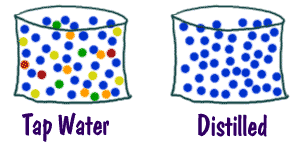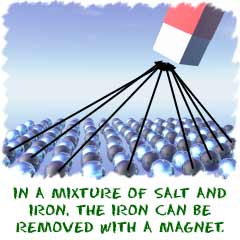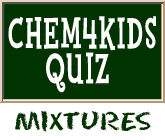
Mixture Basics
Mixtures are absolutely everywhere you look. Most things in nature are mixtures. Look at rocks, the ocean, or even the atmosphere. They are all mixtures, and mixtures are about physical properties, not chemical ones. That statement means the individual molecules enjoy being near each other, but their fundamental chemical structure does not change when they enter the mixture. If the chemical structure changed, it would be called a reaction. When you see distilled water (H2O), it's a pure substance. That means that there are only water molecules in the liquid. A mixture would be a glass of water with other things dissolved inside, maybe one of those powders you take if you get sick. Each of the substances in that glass keeps its own chemical properties. So, if you have some dissolved substances in water, you can boil off the water and still have those dissolved substances left over. If you have some salt (NaCl) in water and then boil off the water, the salt remains in the pan. The salt is left because it takes very high temperatures to melt salt (even more to boil it).
When you see distilled water (H2O), it's a pure substance. That means that there are only water molecules in the liquid. A mixture would be a glass of water with other things dissolved inside, maybe one of those powders you take if you get sick. Each of the substances in that glass keeps its own chemical properties. So, if you have some dissolved substances in water, you can boil off the water and still have those dissolved substances left over. If you have some salt (NaCl) in water and then boil off the water, the salt remains in the pan. The salt is left because it takes very high temperatures to melt salt (even more to boil it).
Mixtures are Everywhere
 There are an infinite number of mixtures. Anything you can combine is a mixture. Think of everything you eat. Just think about how many cakes there are. Each of those cakes is made up of a different mixture of ingredients. Even the wood in your pencil is considered a mixture. There is the basic cellulose of the wood, but there are also thousands of other compounds in that pencil. Solutions are also mixtures, but all of the molecules are evenly spread out through the system. They are called homogenous mixtures.
There are an infinite number of mixtures. Anything you can combine is a mixture. Think of everything you eat. Just think about how many cakes there are. Each of those cakes is made up of a different mixture of ingredients. Even the wood in your pencil is considered a mixture. There is the basic cellulose of the wood, but there are also thousands of other compounds in that pencil. Solutions are also mixtures, but all of the molecules are evenly spread out through the system. They are called homogenous mixtures.
If you put sand into a glass of water, it is considered to be a mixture. You can always tell a mixture, because each of the substances can be separated from the group in different physical ways. You can always get the sand out of the water by filtering the water away. If you were busy, you could just leave the sand and water mixture alone for a few minutes. Sometimes mixtures separate on their own. When you come back, you will find that all of the sand has sunk to the bottom. Gravity was helping you with the separation. Don't forget that a mixture can also be made of two liquids. Even something as simple as oil and water is a mixture.
More on Mixtures in Part II...
► NEXT PAGE ON MATTER
► NEXT STOP ON SITE TOUR
► MIXTURES QUIZ
► RETURN TO TOP OF PAGE
► Or search the sites...
► NEXT STOP ON SITE TOUR
► MIXTURES QUIZ
► RETURN TO TOP OF PAGE
► Or search the sites...
Related Video...
Rocks Under the Microscope (Cambridge University Video)



